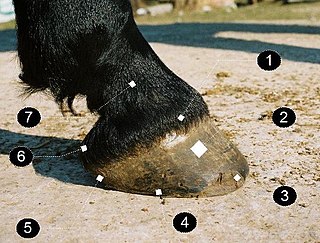 W
WA horse hoof is a structure surrounding the distal phalanx of the 3rd digit of each of the four limbs of Equus species, which is covered by complex soft tissue and keratinised (cornified) structures. Since a single digit must bear the full proportion of the animal's weight that is borne by that limb, the hoof is of vital importance to the horse. The phrase "no hoof, no horse" underlines how much the health and the strength of the hoof is crucial for horse soundness.
 W
WA caulkin from the Latin calx is a blunt projection on a horseshoe or oxshoe that is often forged, welded or brazed onto the shoe. The term may also refer to traction devices screwed into the bottom of a horseshoe, also commonly called shoe studs or screw-in calks. These are usually a blunt spiked cleat, usually placed at the sides of the shoe.
 W
WThe coffin bone, also known as the pedal bone (U.S.), is the bottommost bone in the front and rear legs of horses, cattle, pigs and other ruminants. In horses it is encased by the hoof capsule. Also known as the distal phalanx, third phalanx, or "P3". The coffin bone meets the short pastern bone or second phalanx at the coffin joint. The coffin bone is connected to the inner wall of the horse hoof by a structure called the laminar layer. The insensitive laminae coming in from the hoof wall connects to the sensitive laminae layer, containing the blood supply and nerves, which is attached to the coffin bone. The lamina is a critical structure for hoof health, therefore any injury to the hoof or its support system can in turn affect the coffin bone.
 W
WA farrier is a specialist in equine hoof care, including the trimming and balancing of horses' hooves and the placing of shoes on their hooves, if necessary. A farrier combines some blacksmith's skills with some veterinarian's skills to care for horses' feet.
 W
WThe frog is a part of a horse's hoof, located on the underside, which should touch the ground if the horse is standing on soft footing. The frog is triangular in shape, and extends mid way from the heels toward the toe, covering around 25% of the bottom of the hoof. It acts as a shock absorber for the foot when it makes impact with the ground, decreasing the force placed on the bones and joints of the leg.
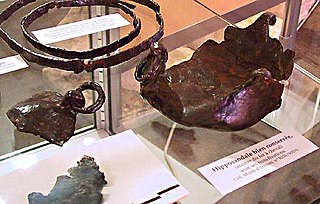 W
WThe hipposandal is a device that protected the hoof of a horse. It was commonplace in the northwestern countries of the Roman Empire, and was a predecessor to the horseshoe.
 W
WA hoof boot is a device made primarily of polyurethane and is designed to cover the hooves of a horse as an alternative to, and occasionally in addition to, horseshoes. Hoof boots can also be used as a protective device when the animal has a hoof injury that requires protection of the sole of the hoof, or to aid in the application of medication. There are many different designs, but all have the goal of protecting the hoof wall and sole of the horse's hoof from hard surfaces, rocks and other difficult terrain.
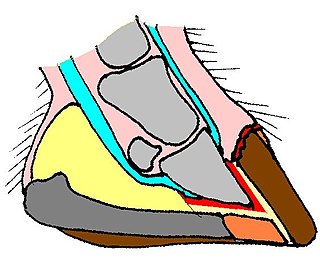 W
WHoof wall separation disease, (HWSD), is an autosomal recessive genetic hoof disease in horses. Research is being carried out at, among others, UC Davis School of Veterinary Medicine in Davis in California. The disease has been found in Connemara ponies and was earlier referred to as Hoof Wall Separation Syndrome, HWSS.
 W
WA horseshoe is a fabricated product, normally made of metal, although sometimes made partially or wholly of modern synthetic materials, designed to protect a horse hoof from wear. Shoes are attached on the palmar surface of the hooves, usually nailed through the insensitive hoof wall that is anatomically akin to the human toenail, although much larger and thicker. However, there are also cases where shoes are glued.
 W
WLaminitis is a disease that affects the feet of ungulates and is found mostly in horses and cattle. Clinical signs include foot tenderness progressing to inability to walk, increased digital pulses, and increased temperature in the hooves. Severe cases with outwardly visible clinical signs are known by the colloquial term founder, and progression of the disease will lead to perforation of the coffin bone through the sole of the hoof or being unable to stand up, requiring euthanasia.
 W
WNail prick or quicking occurs in a horse if the sensitive hoof structures are penetrated by a horseshoe nail being driven through the hoof wall while shoeing. The nail creates a wound on the inside of the hoof wall.
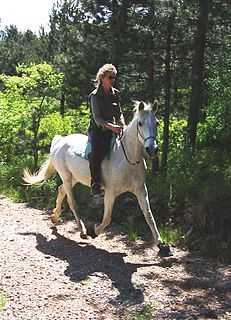 W
WNatural hoof care is the practice of keeping horses so that their hooves are worn down naturally and so do not suffer overgrowth, splitting and other disorders. Horseshoes are not used, but domesticated horses may still require trimming, exercise and other measures to maintain a natural shape and degree of wear.
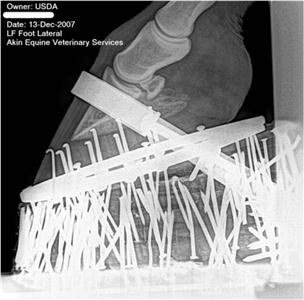 W
WSoring is the use of chemicals or mechanical devices to cause pain to the front feet and legs of horses when they touch the ground. This results in the horses picking up their front feet higher and faster than they would do naturally. It is illegal in the U.S. under the Horse Protection Act of 1970. It is closely associated with a unique high-stepping action of the front legs called "big lick" movement in show ring Tennessee Walking Horses. Under normal circumstances, "big lick" action is normally created by horseshoes that have added pads and weight, usually combined with additional weighted chains or rollers placed around the pasterns to create dramatic, high-stepping flashy action of the horse's front legs, desired in the horse show ring. Practitioners of soring do so because they believe that the pain associated with this practice exaggerates the "big lick" to a greater degree and gives them a competitive edge over other horses. Other breeds that have a history of soring including the Racking Horse and the Spotted Saddle Horse.